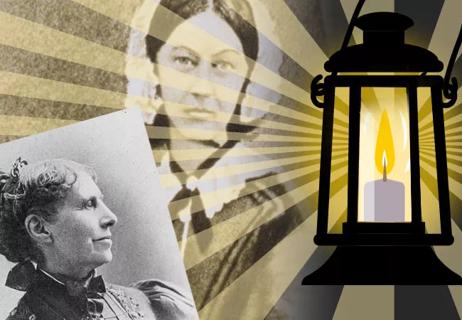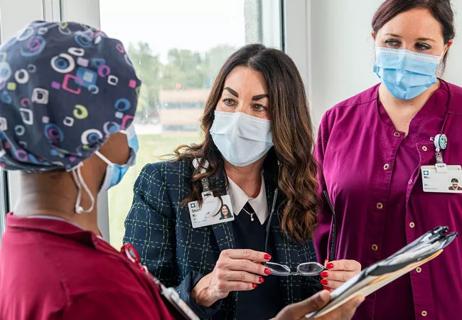Advertisement
Effective communication is key

By Kelly Hancock, DNP, RN, NE-BC
Advertisement
Cleveland Clinic is a non-profit academic medical center. Advertising on our site helps support our mission. We do not endorse non-Cleveland Clinic products or services. Policy
With compassionate, high-quality, safe patient care at the forefront of Cleveland Clinic’s Stanley Shalom Zielony Institute for Nursing Excellence, fostering collaboration and highly integrated working relationships among members of caregiver teams is crucial.
During the course of a four-day hospital stay, a patient may interact with more than 50 different caregivers, including nurses, physicians, patient transporters, lab technicians, patient care nursing assistants, pharmacists and environmental services personnel. Patient handoffs and other critical communication times require caregivers to be cohesive, collaborative and respectful so that important elements of a patient’s care can be communicated accurately and effectively.
The Joint Commission’s guide to improving staff communication suggests that when healthcare professionals are not communicating effectively, patient safety is at risk. Poor interprofessional interactions can result in a lack of critical information being shared. Communication is also given to misinterpretation or misunderstanding when collaboration is not optimal. And, job satisfaction can be negatively affected when there is a lack of collaboration among caregivers.
Cleveland Clinic health system has embarked on a number of initiatives designed to cultivate and enhance caregiver collaboration. For example, focus groups conducted throughout the health system have provided important feedback about how our caregivers interact, communicate and relate with one other. These groups pinpointed opportunities to enhance relationships and offered suggestions to promote interprofessional connections.
Below are a few tips from lessons learned that could help enhance your collaborative practice.
Think about how you introduce yourself to patients and other members of the caregiver team. Do you tell your patients your name along with an explanation that helps to define what your role is for them in their care? For example, “Hi, my name is Jessica Smith and I’m your registered nurse. I’m here to oversee your care and prevent you from harm. Please feel free to call me Jessica.”
There is power and value to being called by your preferred name. Effectively communicating your name and how you would like to be addressed to members of the caregiver team may seem unnecessary, but it can greatly enhance your working relationships, build mutual respect and improve communication. The famed surgeon, author and quality advocate, Atul Gwande, MD (2011), noted in his book, The Checklist Manifesto, that, “people who don’t know one another’s names don’t work together nearly as well as those who do.”
Similarly, nurses should ask their physician colleagues how they would like to be addressed. You may find that a 27-year-old resident who is just beginning her career doesn’t feel comfortable if a nurse with 18 years of experience is calling her, ‘Dr. Smith.’ She may actually prefer being addressed by her first name.
Advertisement
The Interprofessional Educational Collaborative is a consortium of six national educational associations that prepares healthcare providers. It has identified practices that improve the health of individuals and populations, as well as reduce health disparities. The associations recommend participating in educational activities with other professionals to bridge interprofessional gaps and improve teamwork and communication among the caregiver team.
They also believe that each professional gains an awareness of each caregiver’s role on the healthcare team. At Cleveland Clinic, we offer an abundance of programs for interprofessional education. For ideas on helpful offerings, check out Cleveland Clinic’s Center for Excellence in Healthcare Communication and Global Leadership and Learning Institute program listing.
In the practice realm, interprofessional rounding is an ideal way to enhance relationship building among caregivers. Within Cleveland Clinic’s Heart & Vascular Institute units, for example, physicians alert nurses when they will be arriving on the unit(s) so that the nurses can determine how they will prioritize their nursing care and be available to participate in rounds. This highly interactive professional discourse results in a richer clinical picture of the patient, as well as an enhanced understanding of the treatment plan by all members of the caregiver team.
A problem-solving approach that focuses on strengths and appreciative inquiry (AI) was first used at Cleveland Clinic in 1980. AI provides a methodology to change systems, build communities and share strategic vision. Since caregivers tend to center on deficits and how illness or disease has affected a person’s ability to walk, eat or enjoy life, AI provides a refreshing alternative. When embracing an AI approach, all voices are perceived as equal in problem solving.
By starting interprofessional meetings with an appreciative check-in, teams can foster collegiality through compassion and understanding. According to the authors of Appreciative Inquiry in Healthcare, this helps everyone feel capable and can help reconnect people. For example, a physician might share something like, ‘I have been on call for the past eight days and I’m really tired so please be patient with me today,’ or a nursing colleague may mention, ‘I was up last night for several hours caring for my sick child and I just want everyone to know that I will need to check in on him several times today to see how he is doing.’
Expressions of appreciation and gratitude promote good feelings, strengthen relationships and enhance positive problem solving.
This one takes an ample amount of courage for many nurses, but when there is a disagreement about a clinical decision or plan, it is imperative to speak up.
Sometimes nurses are reluctant to say something for fear of disapproval so they may choose to take the path of least resistance and be silent. For example, though it may be more difficult, it is always best to speak up and communicate the changing clinical picture and escalate concerns. It is equally important to share an omission or delay in treatment with the treating physician so that a different course of action can be considered. Each exchange presents an opportunity to form a meaningful connection with another colleague.
Advertisement
When there is true collaboration among caregivers, differing viewpoints are encouraged and accepted by all vested parties. Teaching, learning and listening are commonplace. There is a commitment to the success of each and every member of the team. The work environment is interprofessionally rich and gratifying. As a result, patient care is optimized.
Kelly Hancock is the Executive Chief Nursing Officer of the Cleveland Clinic Health System, and Chief Nursing Officer of Cleveland Clinic Main Campus.
Follow Kelly on Twitter at @kkellyhancock.
Advertisement
Advertisement

The CNO of Cleveland Clinic London shares insight and advice on international nursing

Nurses set goals for rebuilding a committee that waned during the pandemic

By listening closely and responding authentically, leaders can create an environment where nurses feel valued

Communication and self-reflection key to world-class patient care

Nurse leaders play a pivotal role in employee engagement, quality, safety – and, yes, patient care

Text highlights historic contributions to research, education and clinical care

Insights and advice from a nursing leader

Find balance, slow down, seek feedback and more